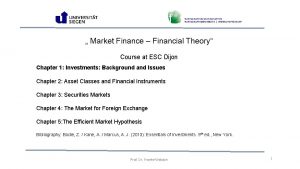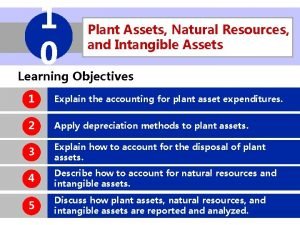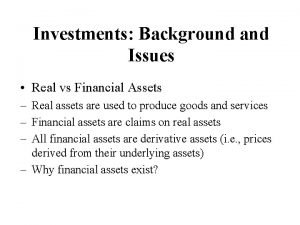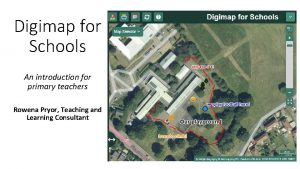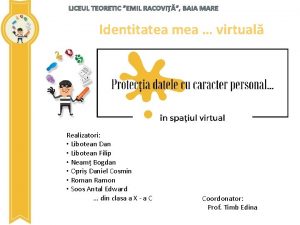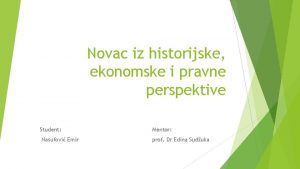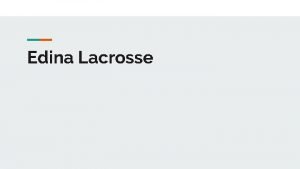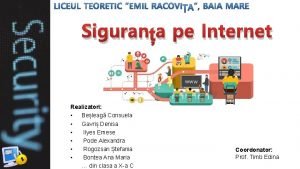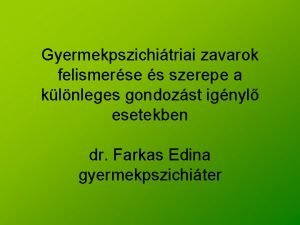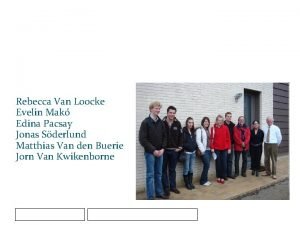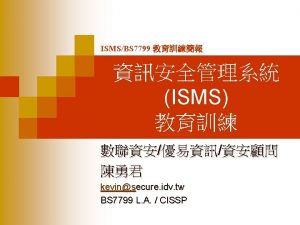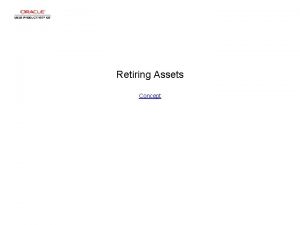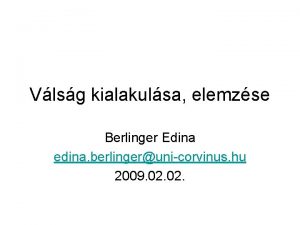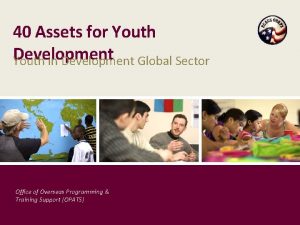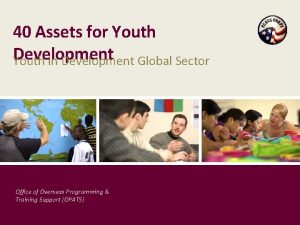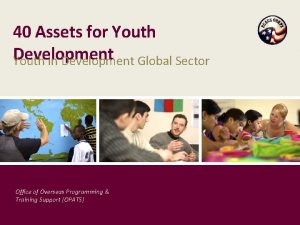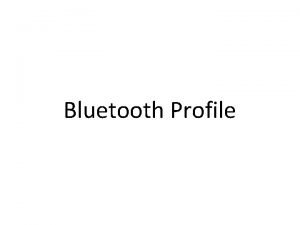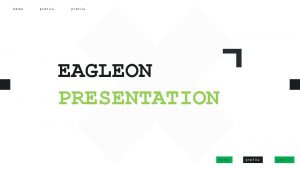Developmental Assets The 2002 Edina Youth Profile Edina










































- Slides: 42

Developmental Assets: The 2002 Edina Youth Profile Edina Public Schools 2002 Search Institute Survey Results 1

Introduction n Search Institute, founded in 1958, generates research and surveys to advance the well being of children and adolescents. n Search Institute Survey: Profiles of Student Life. Up to date, more than one million students in well over 1, 000 US communities have completed the survey; 560 communities have formed assets-building initiatives. n Patterns and Trends: Edina Public Schools took the Search Institute Survey in 1993, 1999 and 2002. 2

2002 Survey National Data n n n Data from the 2002 survey represent 217, 000 public school students in grades 6 through 12. Roughly 318 towns and cities (mostly suburban) in 33 states participated. Most of the communities participating are suburbs that are similar to Edina. 3

Average of Number of Assets Edina Students Possess Vs National Norm 4

Percent of Edina Students Reporting Support from Parents, School and Community 5

Percent of Edina Students Reporting Empowerment 6

Percent of Edina Students Reporting Boundaries and Expectations 7

Percent of Edina Students Reporting Constructive Use of Time 8

Percent of Youth Reporting Commitment to Learning 9

Percent of Youth Reporting Positive Values 10

Percent of Youth Reporting Social Competencies 11

Percent of Youth Reporting Positive Identity 12

Percent of Students Reporting Getting Mostly As and/or Bs on Report Card 13

Percent of Students Who Feel it’s Important to Know People of Other Racial/Ethnic Groups 14

Percent of Students Reporting They Like Doing Exciting Things Even If They Are Dangerous 15

Percent of Students Reporting Teachers Really Care about Them 16

Percent of Students Reporting Skipping School Three or More Days in the Last Four Weeks 17

Percent of Students Reporting Using Alcohol Once or More 18

Percent of Students Reporting Using Alcohol Once or More by Grade 19

Percent of Students Reporting Using Alcohol Once or More in the Last 30 Days 20

Percent of Students Reporting Attending One or More Parties in the Last Year Where Other Kids Their Age Were Drinking 21

Percent of Students Reporting Driving after Drinking Once or More in the Last 12 Months 22

Percent of Students Reporting Riding with a Driver Who Had Been Drinking Once or More in the Last 12 Months 23

Percent of Students Reporting Smoking Cigarettes Once or More 24

Percent of Students Reporting Smoking Cigarettes Once or More During Last 30 Days 25

Percent of Students Reporting Smoking Cigarettes Once or More in the Last 30 Days 26

Percent of Students Reporting Using Smokeless Tobacco Once or More in the Last 12 Months 27

Percent of Students Reporting Using Marijuana Once or More 28

Percent of Students Reporting Using Marijuana Once or More 29

Percent of Students Reporting Using Marijuana Once or More in the Last 12 Months 30

Percent of Students Reporting Using Other Illicit Drugs Once or More in the Last 12 Months 31

Percent of Students Reporting Using Other Drugs Once or More in the Last 12 Months 32

Percent of Students Reporting Having Sexual Intercourse Three or More Times in Lifetime 33

Gender Differences on External Assets 34

Gender Differences on Internal Assets 35

Grade Differences 36

Key Findings in National Comparison n n Overall, Edina students possess 3 more assets than national norm groups, which means that Edina students live in more positive, healthy, caring environment and have greater commitments to learning, stronger competencies and more positive values and higher expectations than students nationwide. Almost 8 out of 10 Edina students report they have strong family support, positive peer influence, constructive youth programs and religious community; the national rates range from 58% to 70%. 37

Key Findings in National Comparison n Almost 8 out of 10 Edina students report strong achievement motivation, work hard on homework, and positive view of personal future; the national rates range from 45% to 70%. Seven out of 10 Edina students value integrity and honesty as important or very important; the national rate is 63%. Edina students report significantly higher in interpersonal competence, cultural competencies, peaceful conflict resolution, restraint skills, self-esteem, and sense of purpose. 38

Key Findings - Changes in 2002 n n Majority of Edina students report success in school--they get mostly As and/or Bs on report card. Percent of students who have resistance skills to avoid dangerous things rose across grades and gender, especially female and 9 th graders. More students feel teachers really care about them, especially high school students. Percent of students who skipped school dropped between 1993 and 1999 and continuously dropped between 1999 to 2002 for most grades. 39

Key Findings--Alcohol Use and Smoking n n Percent of Edina students who use alcohol dropped across grades and gender from 1993 to 1999 and continuously dropped from 1999 to 2002. Also, percent of students who attend parties where other kids at their age were drinking decreased dramatically across grades and gender from 1999 to 2002. Smoking rates among Edina students dropped between 1993 and 1999 and continuously dropped between 1999 and 2002 across grades and gender, especially for boys and grades 9 through 11. Also, students who used smokeless tobacco dropped across grade and gender, especially in high school. 40

Key Findings - Drugs and Sexuality n n n Percent of students who report they use marijuana rose from 1993 to 1999 and dropped from 1999 to 2002. Percent of students who report they use other illicit drugs slightly increased, especially female students and seniors. Overall, percent of students who have sexual intercourse dropped 2% from 1993 to 1999 but rose 3% from 1999 to 2002. 41

Key Findings -Gender and Age n n n Females are more likely to engaged in school, to work hard and do well at school, to report more integrity and honesty, to be involved in activities in or out of school and to have more social competence than males. Males are more likely to show high-risk behaviors or substance abuse. Males are more likely to report lower in almost all assets except safety and self-esteem. Similar to the national patterns, students who gets older have fewer assets. The biggest changes for Edina students occurred in Grades 7 and 8. 42
 Edina youth baseball
Edina youth baseball Developmental assets definition
Developmental assets definition Financial assets examples
Financial assets examples Real assets definition
Real assets definition Plant assets, natural resources, and intangible assets
Plant assets, natural resources, and intangible assets Plant assets natural resources and intangible assets
Plant assets natural resources and intangible assets Real versus financial assets
Real versus financial assets Plant assets natural resources and intangible assets
Plant assets natural resources and intangible assets Real assets vs financial assets
Real assets vs financial assets Digimap for schools login
Digimap for schools login Edina timb
Edina timb Edina sudzuka
Edina sudzuka Edina lacrosse
Edina lacrosse Edina flag football
Edina flag football Edina sinanovic
Edina sinanovic Digimap.edina.ac.uk
Digimap.edina.ac.uk Edina girls lacrosse
Edina girls lacrosse Dr edina
Dr edina Jared edina
Jared edina Radost od boga edina
Radost od boga edina Edina timb
Edina timb Edina football
Edina football Klub 2040
Klub 2040 Edina naviance
Edina naviance Dr farkas edina gyermekpszichiáter
Dr farkas edina gyermekpszichiáter Edina realy
Edina realy Digimap edina
Digimap edina Các châu lục và đại dương trên thế giới
Các châu lục và đại dương trên thế giới Từ ngữ thể hiện lòng nhân hậu
Từ ngữ thể hiện lòng nhân hậu Diễn thế sinh thái là
Diễn thế sinh thái là Tư thế ngồi viết
Tư thế ngồi viết Thế nào là giọng cùng tên? *
Thế nào là giọng cùng tên? * Phép trừ bù
Phép trừ bù Hát lên người ơi alleluia
Hát lên người ơi alleluia Hổ sinh sản vào mùa nào
Hổ sinh sản vào mùa nào đại từ thay thế
đại từ thay thế Vẽ hình chiếu vuông góc của vật thể sau
Vẽ hình chiếu vuông góc của vật thể sau Quá trình desamine hóa có thể tạo ra
Quá trình desamine hóa có thể tạo ra Cong thức tính động năng
Cong thức tính động năng Hình ảnh bộ gõ cơ thể búng tay
Hình ảnh bộ gõ cơ thể búng tay Tỉ lệ cơ thể trẻ em
Tỉ lệ cơ thể trẻ em Thế nào là mạng điện lắp đặt kiểu nổi
Thế nào là mạng điện lắp đặt kiểu nổi Lời thề hippocrates
Lời thề hippocrates


